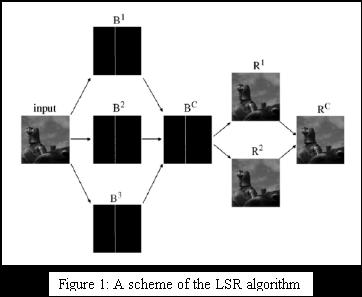Digital Film Restoration Laboratory, ICAR-CNR
A Fusion-based Approach to Digital Movie Restoration
With the recent advent of digital technologies and the ever increasing need for speed and storage, occluded or missing parts in images and movies is a more and more widespread problem. The problem can occur in several multimedia applications, such as wireless communication and digital movie restoration, and can deeply affect also the performance of compression techniques. Our research activity is devoted to the analysis, design, and implementation of methods for the restoration of high-resolution images deriving from film digitalization, and the consequent optimization of restoration processes in high-performance computing environments. Although many algorithms have been proposed in literature for digital movie restoration, none of them ensures a perfect result whichever is the image sequence to be restored. In [1] we proposed a methodology for the solution of classes of problems arising in digital film restoration, that achieves accurate restoration results and naturally adapts to parallel and distributed computing environments. The basic idea of the proposed methodology is to adopt several relatively well settled algorithms for the problem at hand, and combine obtained results through suitable image fusion techniques, with the aim of taking advantage of adopted algorithms capabilities and, at the same time, limiting their deficiencies. Indeed, images obtained from the various restoration modules represent alternative and complementary views and characteristics of the defect area, and their fusion into a single final restored image ensures that information contained in input images is transferred into the fused output image without introducing distortion effects.
 Among the several classes of defects that affect movies, as an example we focused on the class of scratch defects, intended as (total or partial) information loss in a long and thin vertical area of the image sequence, occurring at the same spatial position in several subsequent sequence images, that are caused by the abrasion of the film by dust particles in the slippage mechanisms used for film development, projection, and duplication. Detection and removal modules of the compound algorithm have been chosen among the most accurate methods existing in literature, and both consolidated and innovative image fusion methods have been adopted for the combination of their results. The scheme of the resulting Line Scratch Restoration (LSR) algorithm is given in Fig. 1.
Experimental results on real image sequences show that the proposed approach leads to an evident increased accuracy in restored images as compared to that of the adopted restoration modules. Moreover, the parallel algorithm, based on a combination of data and task partitioning, allows us to achieve high parallel efficiency and is naturally suitable for implementation into computational grid environments, where different geographically distributed resources (not only computing resources, but also data and software modules) can be used and exploited for the solution of the problem at hand.
Among the several classes of defects that affect movies, as an example we focused on the class of scratch defects, intended as (total or partial) information loss in a long and thin vertical area of the image sequence, occurring at the same spatial position in several subsequent sequence images, that are caused by the abrasion of the film by dust particles in the slippage mechanisms used for film development, projection, and duplication. Detection and removal modules of the compound algorithm have been chosen among the most accurate methods existing in literature, and both consolidated and innovative image fusion methods have been adopted for the combination of their results. The scheme of the resulting Line Scratch Restoration (LSR) algorithm is given in Fig. 1.
Experimental results on real image sequences show that the proposed approach leads to an evident increased accuracy in restored images as compared to that of the adopted restoration modules. Moreover, the parallel algorithm, based on a combination of data and task partitioning, allows us to achieve high parallel efficiency and is naturally suitable for implementation into computational grid environments, where different geographically distributed resources (not only computing resources, but also data and software modules) can be used and exploited for the solution of the problem at hand.
References
[1] L. Maddalena, A. Petrosino, G. Laccetti, A Fusion-based Approach to Digital Movie Restoration, Pattern Recognition, DOI 10.1016/j.patcog.2008.10.026, Vol. 42, no. 7, pp. 1485-1495, 2009. [Impact Factor: 3.279]